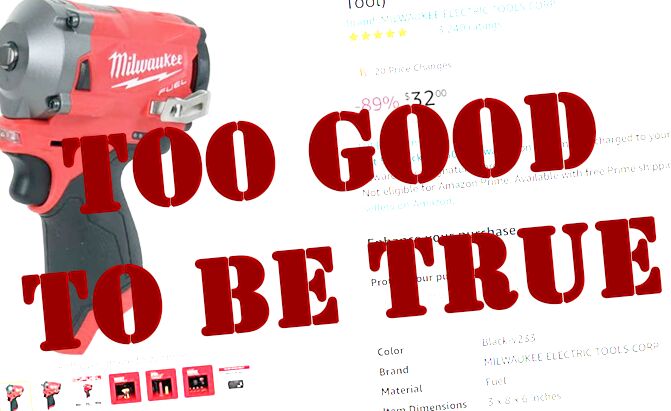How To Protect Yourself From the Amazon Fake Seller Scam

While we were working on our annual Black Friday deal guide, we started to run across a startlingly large number of a specific kind of Amazon scam. Rather than the phishing, credit card, or text scams that usually make the news, these come from fly-by-night sellers with amazing deals, popping up right now during the first rush of holiday shopping. They have listings for legitimate products, but their prices undercut all the real sellers. What’s worse, Amazon’s algorithms that recommend products and sellers sometimes bring these scams to the front, scooping up enough sales to make a profit and disappear before the retailer catches on and bans them. But by then, it’s too late: They’ve got the payments, and are busy coming up with their next grift.
Because these storefronts have extremely short life expectancies—often only a few hours—these Amazon scams are very hard to single out. So this year, we teamed up with our sister site Red Flag Deals in Canada to show you what this kind of Amazon scam looks like, and how to avoid it. To do so, we researched dozens of deeply discounted name-brand products, and uncovered a disturbing trend: Fake storefronts have been proliferating on Amazon since at least June, 2022, and as fast as the company takes them down, new ones appear. The only reason that would keep happening is if there’s money in it.
Because any given seller is usually so short-lived, we collected examples both of listings, and of the sorts of storefronts they come from. But we could use your help: If you’ve seen, or been scammed by, one of these stores, please either let us know in the comments, or tell your story on RFD. We haven’t been able to verify exactly what’s going on with Amazon, but it’s a wild coincidence if there’s another explanation.
In the end, your best defense is common sense: If it looks too good to be true, it probably is.
Table of contents
How the Amazon Fake Seller Scam Works

It's all too easy for these scammers to slip in between the real deals at this time of year. If you're used to seeing legitimate 40% off Black Friday sales, 60% off can just seem like an extra good deal...and 80% off might look like a pricing error that you don't want to think about too much.
Many major retailers, but especially Amazon and Walmart, have marketplaces where almost anyone can start selling with not much more than a bank account, credit card, and ID. So if a scammer thinks they can recover the minor up front fees, and avoid fraud detection for long enough, they can pop up a store front, populate it with a mix of items, collect some sales, and evaporate.
All the major sites have extensive fraud prevention teams—but Walmart, Best Buy, and especially Amazon have massive ongoing layoffs, and it's entirely possible the proliferation of fraudulent sellers is related to reduced staffing in technology departments.
Fake Tracking InformationOnce a buyer places an order, users are reporting that the scammers often provide a fake tracking number. "Seller provided me an old already-delivered tracking number for my item," said one buyer on the wuhanqiuyanshangmaoyouxiangongsi store page. "Tracking number I got shows the parcel was sent to an entirely different state. Never received the product," said another on Custom-US (which we found out was the seller "jinanxiangroujinawangluokejifuwuyouxiangongsi." See the next section for more on these wild names.
How to Identify a Fake Storefront

The items themselves are legitimate, and popular. The fake storefront games the listings by "selling" it at a lower price, which the retailer's algorithm surfaces as a deal, and lists as the price on the main product page. Typically, they offer free shipping, but with a date a week or so out, so you won't start asking questions too soon. To look more legitimate, the storefront is often filled out with an assortment of other household and electronics items, which may or may not be at the same "discounts" as the bait.
Your two big clues are the low, low price; and the seller. They mostly have unintelligible names (often ending with "si") like "HaiKouYaoChuangYuWangLuoKeJiYouXianGongSi,""GuangZhouMinRuiShangMaoYouXianGongSi," and "Qionghaibaihechaokejiyouxiangongsi," which are generally either nonsense, or something like "Dongguan Zhonggu Trading Co., Ltd. ("dongguanshizonggushangmaoyouxiangongsi"). There are a few oddballs like "Mgangg" thrown in there to confuse the issue. We've spotted a few of them rebranding, like jinanxiangroujinawangluokejifuwuyouxiangongsi renaming itself Custom-US, which looks a lot less suspicious in the Ships from/Sold by information.
You'll find the "Ships from/sold by" information under the Buy buttons. If it isn't shipped and/or sold by the brand or Amazon, it's a third party seller. Most third-party sellers on Amazon are legitimate, but you should always investigate.
Most seller pages are more or less blank, although we've found a few that have been laying the groundwork for months (see the first section). If you see one with dozens of reviews going back at least a year, you're probably OK. But when you run into Nanningshihuamaoyiyouxiangongsi's page, that's the time to look for a different seller.
Scam Pricing StrategiesAs retailers play whack-a-mole with popup fake sellers, the scammers adjust their strategy to fly under the radar a little longer. In addition to coming up with better names, they're employing slightly more credible discounts. What might have been an unbelievable 85% off becomes 55% off, which is even more likely to avoid hard questions during a season when there are hundreds of thousands of legitimate deals. Some others, like we've seen from 琼海纪钰涵科技有限公司 (qionghaijiyuhankejiyouxiangongsi), are gaming the system more subtly, with discounts that are just low enough to remain the cheapest—and most attractive—option.
How To Protect Yourself from Marketplace Scams

The RFD forums are full of stories about shady marketplace sellers, and there are a few tools we wouldn't live without. Our favorite, and one that helped us with this story, is Fakespot, a Chrome extension which looks for deceptive selling practices. It has some limitations (including the fact it's a Chrome extension), but it does a very good job of popping up a "New Seller" notice, which helps you know when to take a deeper look.
In our everyday product research, we also use ReviewMeta and No Valid Product, neither of which will help with sellers, but are a tool to help unearth deceptive review practices. If you're interested in learning more about other online shopping scams, there are some great articles, and as always, the enthusiastic shoppers at RFD. If you're shopping for auto parts, there's a specific auto parts scam to watch out for, too.
We also like the Honey app, which points out how big a deal you're getting compared to other sellers across several different sites.
What to Do If You've Been Scammed

We can't emphasize enough how short-lived most of these are. Most of the storefronts we spotted in the morning were gone by lunchtime. If you think you were the victim of this kind of Amazon scam, check to see whether your item shipped, and if the seller still exists,. When Amazon removes a seller, it does so without a trace, or any other helpful indication it was ever even there.
One of the few toll-free numbers Amazon still has is 866-216-1075, to report fraud. There are also pages to report security issues, and to report suspicious activity. If you don't have any luck with those, please let us know and we'll try to help out.
Recent Updates
November 16, 2022: We found some first-hand accounts of people who had been scammed, and addional details on how these Amazon scams work.
We are committed to finding, researching, and recommending the best products. We earn commissions from purchases you make using the retail links in our product reviews. Learn more about how this works.
AutoGuide may accept review samples for testing and evaluation. Suppliers of review products do not have any input into our conclusions and are not allowed to review our content before publication.

After completing a degree project in automotive design, Dave wrote and photographed for almost a decade in print car magazines (remember those?), before transitioning to digital. He now subjects a series of old high-performance cars to the roads and weather in Vermont and wonders why they're always expensively broken. Please stop when you see him crawling under one on the side of the road.
More by David Traver Adolphus









































Comments
Join the conversation